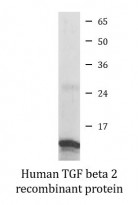ARG70107
Human TGF beta 2 recombinant protein (Active) (His-tagged, C-ter)
Human TGF beta 2 recombinant protein (Active) (His-tagged, C-ter) for SDS-PAGE
Overview
| Product Description | E. coli expressed, His-tagged (C-ter) Active Human TGF beta 2 recombinant protein |
|---|---|
| Tested Application | SDS-PAGE |
| Target Name | TGF beta 2 |
| Species | Human |
| A.A. Sequence | Ala303 - Ser414 |
| Expression System | E. coli |
| Activity | Active |
| Activity Note | Determined by its ability to inhibit IL-4-induce proliferation in HT-2 cells. The ED50 for this effect is < 0.2 ng/mL. The specific activity of recombinant human TGF beta 2 is > 5 x 10^6 IU/mg. |
| Alternate Names | TGF-beta2; Cetermin; LDS4; Polyergin; Glioblastoma-derived T-cell suppressor factor; G-TSF; Transforming growth factor beta-2; LAP; TGF-beta-2; BSC-1 cell growth inhibitor |
Properties
| Form | Powder |
|---|---|
| Purification Note | Endotoxin level is < 0.01 EU/µg of the protein, as determined by the LAL test. |
| Purity | > 98% (by SDS-PAGE) |
| Buffer | 20 mM Sodium citrate and 0.2 M NaCl (pH 3.5). |
| Reconstitution | It is recommended to reconstitute the lyophilized protein in sterile water to a concentration not <100 µg/ml and incubate the stock solution for at least 20 min at room temperature to make sure the protein is dissolved completely. |
| Storage Instruction | For long term, lyophilized protein should be stored at -20°C or -80°C. After reconstitution, aliquot and store at -20°C or -80°C for up to one month. Storage in frost free freezers is not recommended. Avoid repeated freeze/thaw cycles. Suggest spin the vial prior to opening. |
| Note | For laboratory research only, not for drug, diagnostic or other use. |
Bioinformation
| Gene Symbol | TGFB2 |
|---|---|
| Gene Full Name | transforming growth factor, beta 2 |
| Background | This gene encodes a member of the transforming growth factor beta (TGFB) family of cytokines, which are multifunctional peptides that regulate proliferation, differentiation, adhesion, migration, and other functions in many cell types by transducing their signal through combinations of transmembrane type I and type II receptors (TGFBR1 and TGFBR2) and their downstream effectors, the SMAD proteins. Disruption of the TGFB/SMAD pathway has been implicated in a variety of human cancers. The encoded protein is secreted and has suppressive effects of interleukin-2 dependent T-cell growth. Translocation t(1;7)(q41;p21) between this gene and HDAC9 is associated with Peters' anomaly, a congenital defect of the anterior chamber of the eye. The knockout mice lacking this gene show perinatal mortality and a wide range of developmental, including cardiac, defects. Alternatively spliced transcript variants encoding different isoforms have been identified. [provided by RefSeq, Sep 2010] |
| Function | TGF-beta 2 has suppressive effects on interleukin-2 dependent T-cell growth. [UniProt] |
| Cellular Localization | Secreted. [UniProt] |
| PTM | The precursor is cleaved into mature TGF-beta-2 and LAP, which remains non-covalently linked to mature TGF-beta-2 rendering it inactive. [UniProt] |
Images (1) Click the Picture to Zoom In






